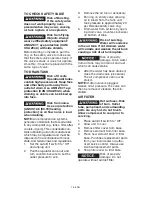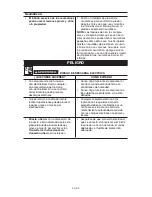
14- ENG
How to Start
1. Turn the Auto/Off switch to "Auto"
and allow tank pressure to build.
Motor will stop when tank pres-
sure reaches "cut-out" pressure.
2. Pull the regulator knob out and
turn clockwise to increase
pressure. When the desired
pressure is reached push knob in
to lock in place. The compressor
is ready for use.
Risk of fire or
explosion. Always
operate the air compressor in well-
ventilated areas free of gasoline
or other combustible vapors. If
the compressor is being used to
operate a sprayer DO NOT place
near the spray area.
If any unusual
noise or vibration
is noticed, stop the compressor
immediately and have it checked by
a trained service technician.
The compressor is ready for use.
MAINTENANCE
CUSTOMER RESPONSIBILITIES
Procedure
Daily
Daily
or after
each use
Weekly
See tank
warning
label
Check safety valve
X
Inspect air filter
X
1
Drain air tank
X
Check for unusual noise/vibration
X
Check for air leaks
X
*
Clean compressor exterior
X
Remove tank from service
X
2
*
To check for air leaks apply a solution of soapy water around joints. While
compressor is pumping to pressure and after pressure cuts out, look for air
bubbles to form.
1 - more frequent in dusty or humid conditions
2
- For more information, contact a Trained Service Technician
Risk of Unsafe
Operation. Unit
cycles automatically when power
is on. When servicing, you may
be exposed to voltage sources,
compressed air, or moving parts.
Before servicing unit unplug or
disconnect electrical supply to
the air compressor, bleed tank
of pressure, and allow the air
compressor to cool.
To ensure efficient operation and lon-
ger life of the air compressor, a routine
maintenance schedule should be pre-
pared and followed. The above routine
maintenance schedule is geared to an
air compressor in a normal working
environment operating on a daily basis.
If necessary, the schedule should be
modified to suit the conditions under
which your air compressor is used.
The modifications will depend upon
the hours of operation and the work-
ing environment. Compressors in an
extremely dirty and/or hostile environ-
ment will require a greater frequency of
all maintenance checks.
NOTE:
See
Operation
section for the
location of controls.















































